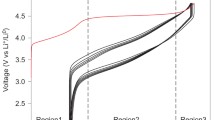Abstract
Praseodymium oxide is one of the group of binary oxides that show a wide range of stoichiometry, but in which the deviation from the ideal stoichiometry is not continuous, as is expected from the classical model of randomly distributed isolated point defects. Instead, there is a number of phases of unique structures and stoichiometries with no appreciable concentrations of point defects, and thus essentially no compositional width. These structures are closely related to each other, and to a simple parent structure. In the case of praseodymium oxide this is the fluorite structure.
Transitions between these phases upon heating and cooling, as well as upon changes in the oxygen activity of the environment, occur very rapidly, indicating unusually high oxygen mobility. The equilibrium phase at ambient temperature in air is not PrO2, but Pr6O11.
These phases have been shown to have cation sublattices essentially identical to that of fluorite-type PrO2. The stoichiometric changes are accommodated by the presence of topotactically ordered arrangements of large localized concentrations of oxide ion vacancies which divide the structure up into microdomains.
Experiments have shown that Pr6O11 can absorb significant amounts of water, even at ambient temperature, apparently by the electrically neutral mechanism proposed by Stotz and Wagner. This involves the absorption of oxide ions at sites where there were previously oxide ion vacancies. Protons are also absorbed, and reside in interstitial sites. Consistent with the high mobility of oxygen in this structure, this water is irreversibly desorbed at relatively low temperatures.
Electrochemical experiments will be reported that have been undertaken to investigate the insertion behavior of lithium into these unusual structures, both with and without the initial presence of protons as the result of the absorption of water.
Similar content being viewed by others
References
L. Eyring and M. O'Keeffe, “The Chemistry of Extended Defects in Non-metallic Solids”, North-Holland, 1970.
K. Kosuge, “Chemistry of Non-Stoichiometric Compounds”, Oxford University Press, 1994.
B.G. Hyde, D.J.M. Bevan and L. Eyring, “On the Praseodymium + Oxygen System”, Phil. Trans, Royal Soc.A259, 583 (1966).
U. Lott, “Elektrochemische Messung der Thermodynamischen Größen im binären System Praseodymium-Sauerstoff”, PhD Thesis, Univ. of Karlsruhe (1968).
D.A. Burnham and L. Eyring, “Phase Transformations in the Praseodymium Oxide - Oxygen System: High Temperature X-Ray Diffraction Studies”, J. Phys. Chem.72, 4415 (1968).
J. Kordis and L. Eyring, “A Tensimetric Study of the Terbia and Praseodymia Systems and the Mixed Praseodymia-Terbia System”, J. Phys. Chem.72, 2044 (1968).
Personal communication, W.R. Kallman, Eyeonics Corp., Tualatin, OR, USA.
R. Wolf and R. Hoppe, J. Solid State Chem.70, 12 (1987).
S. Stotz and C. Wagner, Ber. Bunsenges. physik. Chem.70, 781 (1966).
C. Wagner, Ber. Bunsenges. Physik Chem.72, 778 (1968).
Author information
Authors and Affiliations
Rights and permissions
About this article
Cite this article
Netz, A., Chu, W.F., Thangadurai, V. et al. Investigations of praseodymium oxide electrodes in lithium concentration cells. Ionics 5, 426–433 (1999). https://doi.org/10.1007/BF02376009
Received:
Accepted:
Issue Date:
DOI: https://doi.org/10.1007/BF02376009



